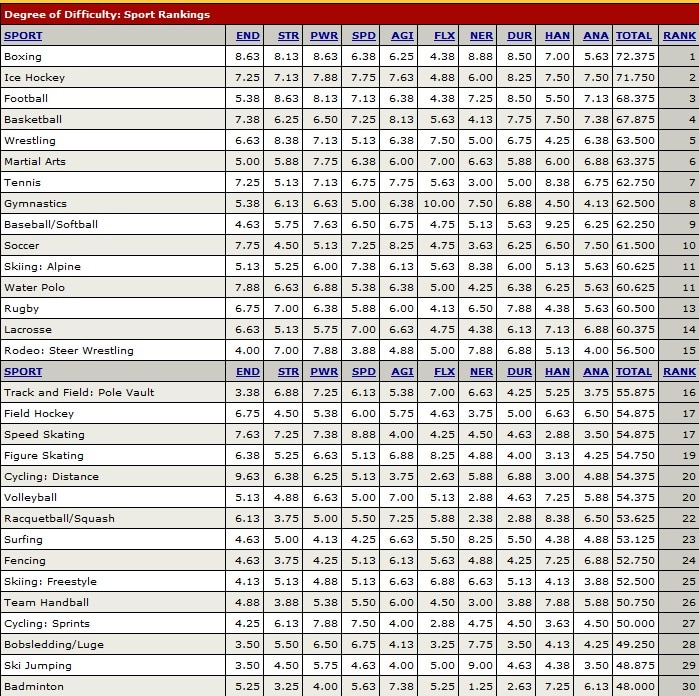[h=1]Which Sport Requires the Most Athleticism[/h]
Several years ago, a panel of experts sought to answer the controversial question of which sport is the most difficult. The experts used 10 categories to try and figure out which sport requires the most athleticism. The panel included sports scientists on the Olympic Committee, researchers who study human muscle and movement, an athlete who competed successfully at both baseball and football (Brian Jordan), and sports journalists who spend their lives documenting the rise and fall of the best athletes.
To try to objectively rank the 60 sports in contention, the panelists broke each sport down to 10 separate components, as follows:
<iframe marginwidth="0" marginheight="0" scrolling="no" frameborder="0" height="120" width="600" id="_mN_main_825858783_1_n" style="margin: 0px; padding: 0px; border-width: 0px; border-style: initial; outline: 0px; vertical-align: baseline; max-width: 100%; background: transparent;"></iframe>
<tbody style="margin: 0px; padding: 0px; border: 0px; outline: 0px; vertical-align: baseline; background: transparent;">
</tbody>
Using the 10 categories, the panelists gave each sport a score under each category, with a maximum of 10 points per category. Then, the points are added to a total of 100 points maximum. Note that there aren’t any sports that totaled up to 100 points, but that is the absolute maximum one sport can get.
After all was said and done, here are the results of how the panelists ranked the 60 sports according to which one takes the most athleticism to succeed. Remember, it is not which sport takes the most time to learn to play leisurely, the ranking is according to which sport takes the most athleticism to be good at.
- September 14, 2014 /
- Health and Fitness /
- By Tri /
- 5COMMENT
Several years ago, a panel of experts sought to answer the controversial question of which sport is the most difficult. The experts used 10 categories to try and figure out which sport requires the most athleticism. The panel included sports scientists on the Olympic Committee, researchers who study human muscle and movement, an athlete who competed successfully at both baseball and football (Brian Jordan), and sports journalists who spend their lives documenting the rise and fall of the best athletes.
To try to objectively rank the 60 sports in contention, the panelists broke each sport down to 10 separate components, as follows:
<iframe marginwidth="0" marginheight="0" scrolling="no" frameborder="0" height="120" width="600" id="_mN_main_825858783_1_n" style="margin: 0px; padding: 0px; border-width: 0px; border-style: initial; outline: 0px; vertical-align: baseline; max-width: 100%; background: transparent;"></iframe>
| ENDURANCE: The ability to continue to perform a skill or action for an extended period of time. Example: cyclists or distance runnersSTRENGTH: The ability to produce force (force=mass*acceleration). Example: NFL defensive linemen or weight-liftersPOWER: The ability to produce strength in the shortest possible time. Example: baseball sluggersSPEED: The ability to move your body quickly. Example: Sprinters, speed skaters, or NFL wide receiversAGILITY: The ability to change direction quickly. Example: Baseball shortstops or basketball playersFLEXIBILITY: The ability to stretch the joints across a large range of motion. Example: Gymnasts, divers, or figure skatersNERVE: The ability to overcome fear and control your body’s stress response. Example: boxers and race car drivers.DURABILITY: The ability to withstand physical punishment over an extended period. Example: Boxers or football players (especially running backs)HAND-EYE COORDINATION: The ability to react quickly to sensory perception. Example: A baseball player reacting to a knuckleball ANALYTIC APTITUDE: The ability to evaluate, reevaluated, and react appropriately to strategic situations. Example: Russell Wilson breaking down the defense before hiking the ball. 

|
<tbody style="margin: 0px; padding: 0px; border: 0px; outline: 0px; vertical-align: baseline; background: transparent;">
</tbody>
Using the 10 categories, the panelists gave each sport a score under each category, with a maximum of 10 points per category. Then, the points are added to a total of 100 points maximum. Note that there aren’t any sports that totaled up to 100 points, but that is the absolute maximum one sport can get.
After all was said and done, here are the results of how the panelists ranked the 60 sports according to which one takes the most athleticism to succeed. Remember, it is not which sport takes the most time to learn to play leisurely, the ranking is according to which sport takes the most athleticism to be good at.





